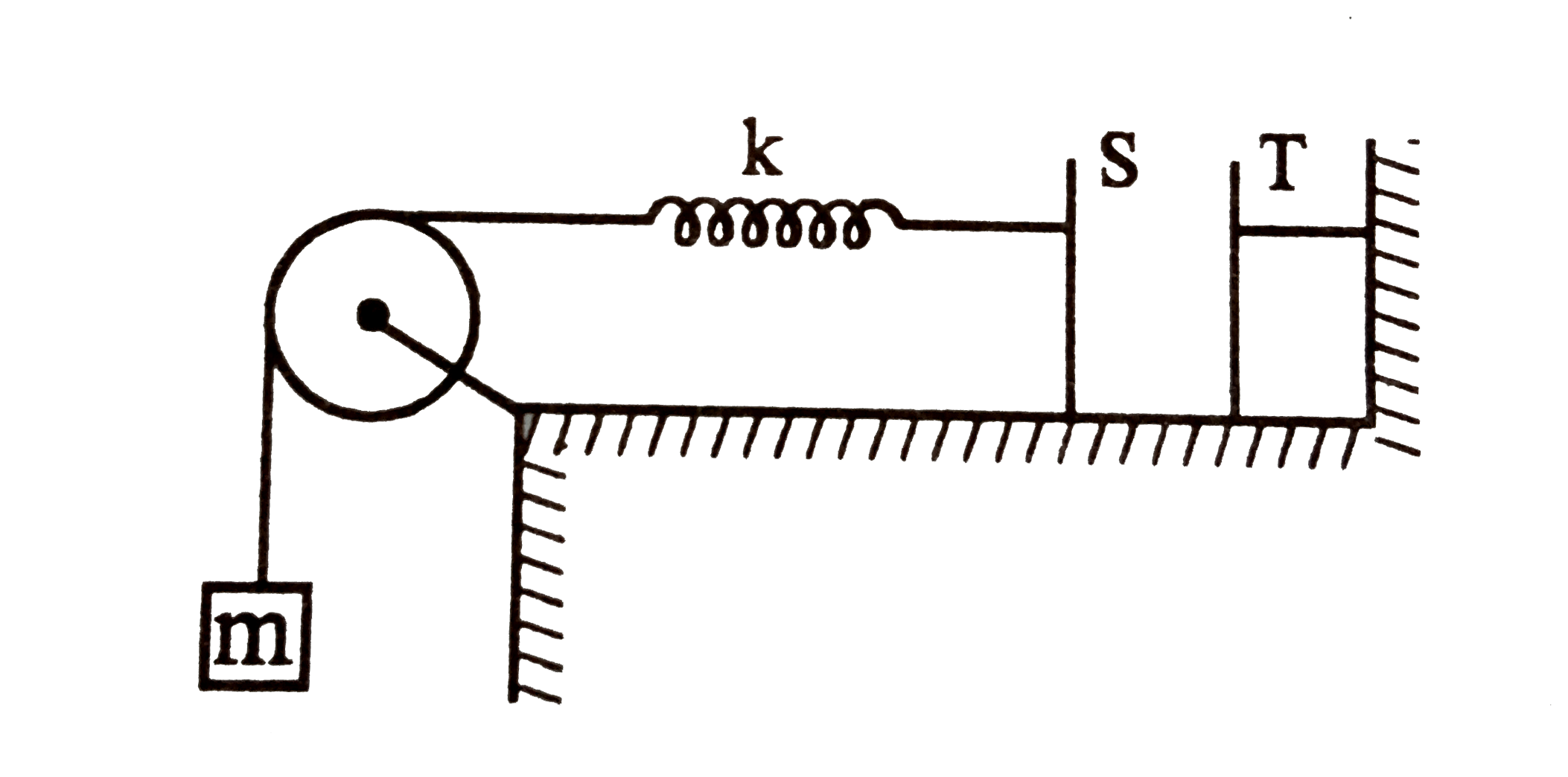One plate of a parallel plate capacitor is connected to a spring as shown in the figure. The area of each plate of the capacitor is A when the battery is not connected and the spring is unstreteched. After connecting the battery, in the steady state the distance between the plates is 0.75 d , then the force constant of the spring is
 Solution in Telugu
Solution in Telugu
38ε0V2Ad3
83ε0V2Ad3
932ε0V2Ad3
329ε0V2Ad3
The correct Answer is:D
In equilibrium , force between plates of capactor = spring force = q22ε0A=kx where , x = extension n spring is unstretched (x=0) distance of plates is and afer charging it is 3/4 d.
So, x=d−34d=14d<br>Hence,K=q22ε2A⋅x=C2V22ε0Ax
=⎧⎪
⎪
⎪
⎪
⎪⎨⎪
⎪
⎪
⎪
⎪⎩ε20A2(34d)⋅V22ε0A⋅14d⎫⎪
⎪
⎪
⎪
⎪⎬⎪
⎪
⎪
⎪
⎪⎭=329(ε0V2Ad3)
Topper's Solved these Questions
Similar Questions
A nucleus of deuterons or deuterium is a bound atomic system best described by
View SolutionThe pressure on a circular plate is measured by measuring the force on the plate and the radius of the plate. If the errors in measurement of the force and the radius are 5% and 3% respectively, the percentage of error in the measurement of pressure is
View SolutionA parallel plate capacitor is connected across a battery. Now, keeping the battery connected, a dielectric slab is inserted between the plates. In the process,
View SolutionOne plate of a capacitor is fixed, and the other is connected to a spring as shown in. Area of both the plates is A In strady state (equilibrium), separation between the plates is 0.8d (spring was unstretched , and the distance between the plates was d when capacitor was uncharged). The force conntant of the spring is approximately.

View SolutionThe plates S and T of a uncharged parallel plate capacitor are connected across a battery. The battery is then disconnected and the charged plates are now connected in a system as shown in the figure. The system shown is in equilibrium. All the strings are insulating and massless. the magnitude of charge on one of the capacitor plates is: [Area of plates =A]

View SolutionA parallel plate capacitor is charged by connecting is plates to the terminals of a battery. The battery remains connected to the condenser plates and a glass plate is interposed between the plates of the capacitor, then
View SolutionTwo parallel plate capacitors with area A are connected through a conducting spring of natural length 1 in series as shown. Plates P and save fixed positions at separation d. Now the plates are connected by a battery of emfξ as shown. If the extension in the spring in equilibrium is equal to the separation between the plates, find the spring constant k.
 .
.
View SolutionA paallel plate capacitor with air as a dielectric is arranged horizontally. The lower plate is fixed and the other connected with a perpendicular spring. The area of each plate is A and mass of uppar plate is m. In the steady position, the distance between the plates is d0. When the capacitor is connected with a battery of emf V, a new equilibrium appears, with distance between the plate as d.
(a) find the spring constant k.
(b) what is the maximum voltage for a given k in which an equilibrium is possible?

View SolutionA condcuting slab of thickness d/2 is inserted between the plates of parallel plate capacitor as shown in the figure . The energy stored in the capacitor when terminals of capacitor are connected across a battery of emf 2V is (plate area is A)
View SolutionA parallel plate capacitor is charged by connecting it to a battery. The battery is disconnected and the plates of the capacitor are pulled apart to make the separation between the plates twice. Again the capacitor is connected to the battery (with same polarity) then
View SolutionOne plate of a capacitor is connected to a spring as shown. Area of both the plate is A and separation is d when capacitor is uncharged. When capacitor is charged, in steady state separation between the plates is 0.8 d. The force constant of the spring is approximately :

View SolutionThe plates S and T of an uncharged parallel plate capacitor are connected across a battery. The battery is then disconnected and the charged plates are now connected in a system as shown in the figure. The system shown is in equilibrium. All the strings are insulating and massless. The magnitude of charge on one of the capacitor plates is: [Area of plates = A]

View SolutionOne plate of a capacitor is connected to a spring as shown. Area of both the plate is A and separation is d when capacitor is uncharged. When capacitor is charged, in steady state separation between the plates is 0.8 d. The force constant of the spring is

View SolutionA parallel plate capacitor is connected across a battery. Now, keeping the battery connected, a dielectric slab is inserted between the plates. In the process,
View SolutionOne plate of a capacitor is fixed, and the other is connected to a spring as shown in. Area of both the plates is A In strady state (equilibrium), separation between the plates is 0.8d (spring was unstretched , and the distance between the plates was d when capacitor was uncharged). The force conntant of the spring is approximately.

View Solution

